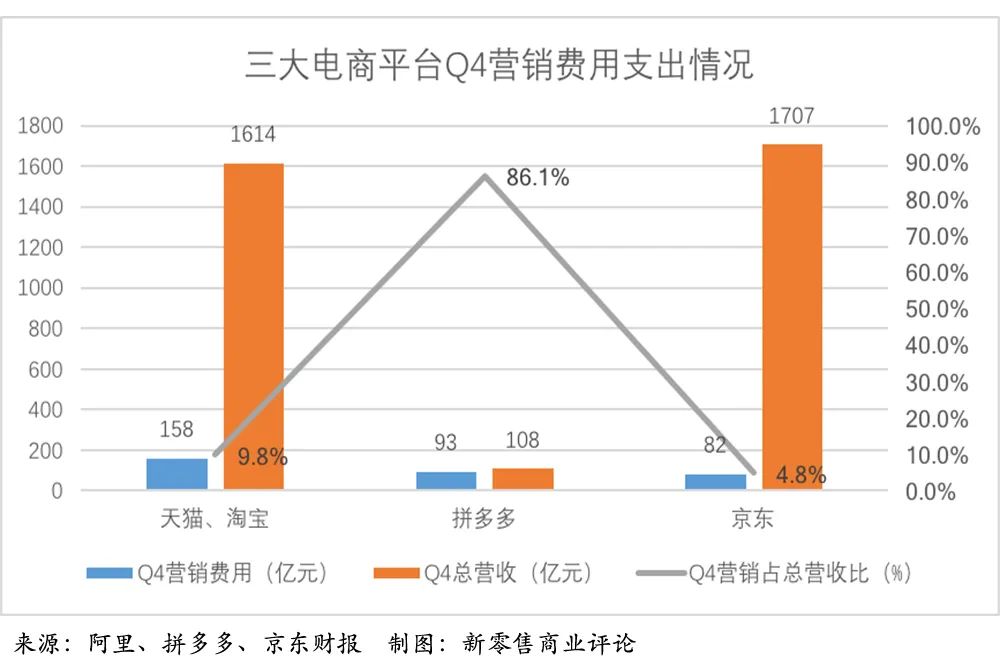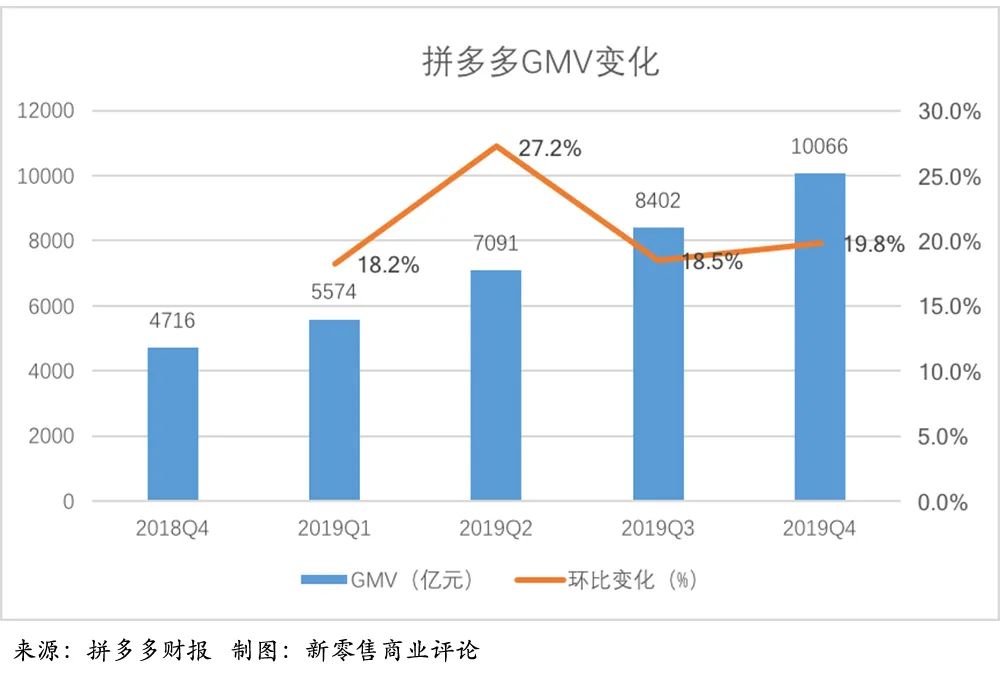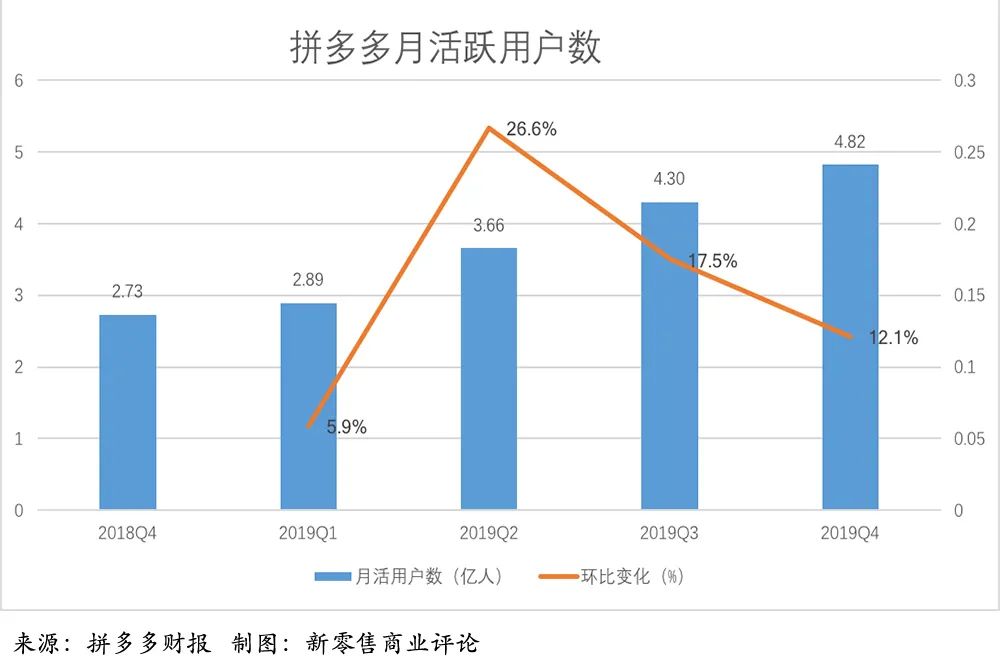You’re cheap, I’m cheaper than you.
Editor’s note: This article comes from WeChat public account “New Retail Business Review” (ID: xinlingshou1001), author Tang Suyi.
On March 11, 2020, Pinduoduo issued the latest quarterly financial report. The best thing about it is the following two sets of data:
Embarking on the “Gigabit Platform Transaction Volume (GMV)”, Pinduoduo only took 5 years, while Ali and Jingdong took 14 and 20 years, respectively.
At the same time, the number of Pinduoduo platform users has increased from nearly 300 million in June 2018 to 600 million.
However, the capital market is not buying. As soon as the US stock market opens, the stock price of Pinduoduo has dropped by nearly 7%. As of March 12, the stock price of Pinduoduo still maintained a decline of about 7%.
Guo Sheng Securities gave a rating of “Reduce” to Pinduoduo, saying that the price of Pinduoduo has 62.2% downside compared to the current stock price, and bluntly stated: “Pinduoduo is currently the largest bubble in China’s Internet history.”
Everything is due to subsidies
The reason for the decline in stock prices is mainly the decline in revenue and continued losses, all of which are related to subsidies.
According to the financial report data, in the whole year of 2019, Pinduoduo’s revenue was 30.1 billion yuan, a month-on-month growth rate (43.6%) that was far less than 60.2% of Q2; operating losses were about 2.14 billion yuan, and annual net loss was 7 billion yuan.
This is in sharp contrast to rising marketing costs. In Q4 of 2019, the marketing expenses of Pinduoduo reached 9.3 billion yuan, an increase of 34.8% from the previous month. The marketing expenses for the whole year of 2019 reached 27.2 billion yuan, which doubled from the previous year (102.2%).

Pingduoduo Q4 generated 10.79 billion yuan in revenue, 86% was spent on tens of billions of subsidies in marketing activities. The huge marketing expenditure caused by the subsidy has indeed brought new users to Pinduoduo – monthly active users (MAU) increased by 76.7% year-on-year to 482 million people, but at the same time, the profitability of Pinduoduo has become distant.
Compared to a lot of aggressive, its competitors are more robust. According to the financial reports of Ali and Jingdong, the marketing expenses of their respective e-commerce platforms accounted for only 9.8% and 4.8% of total revenue.

Obviously, at present, Pinduoduo is still purely based on subsidies as its core strategy. However, it is not difficult to see from several financial report data that once the subsidy intensity drops, revenue and platform transaction volume will also decline. However, Pinduoduo is still inseparable from the “subsidy” of this expensive special effect drug.
Pin Duoduo Strategy Vice President David Liu said at the financial conference that subsidies will increase the frequency of purchases and per capita consumption of users on the Pinduoduo platform, and the current subsidy strategy will continue.
The response of the stock market shows from another aspect that the capital market has a profitable requirement for Pinduoduo. However, in addition to relying on data indicators such as the number of users, monthly activity, and sharing rate brought by burning money, Pinduoduo has not made a clear picture of how to make a profit.
In addition to being beaten by the capital market, Pinduoduo has more troubles.
First, Subsidies have brought a lot of goodness to Pinduoduo, but at the same time bottlenecks have also begun to appear , for example, GMV (gross turnover) and user growth have slowed down.
Under the dual stimulus of 10 billion subsidies and shopping festivals, Pinduoduo GMV broke through the trillion mark to reach 106.6 billion yuan, an increase of 113% year-on-year. Among them, the growth rate of GMV in the third, fourth and second quarters slowed down significantly.

In Q4 2019, the monthly active users of the platform increased by 51.9 million, but the increase in the fourth quarter was only 12.1%, which was a significant decline compared to Q2 and Q3.

Second, After Ali and JD joined the sinking market one after another, their strength in logistics and supply chain has become a problem that must be addressed, and it is obviously impossible to avoid subsidies by burning money alone. Can’t escape.
There is no supply chain before and no self-built logistics after. The cost of omnichannel is obviously higher than that of Ali and JD. Although Pinduoduo gained scale by burning money, a large amount of money was spent on multi-phase subsidies for merchants and consumers, and it was not spent on reducing the cost of the full link.
According to Guosheng Securities, the cost rate of Pinduoduo is 23.8%, which is nearly 10% higher than that of Ali (12.8%) and JD.com (15.2%).



